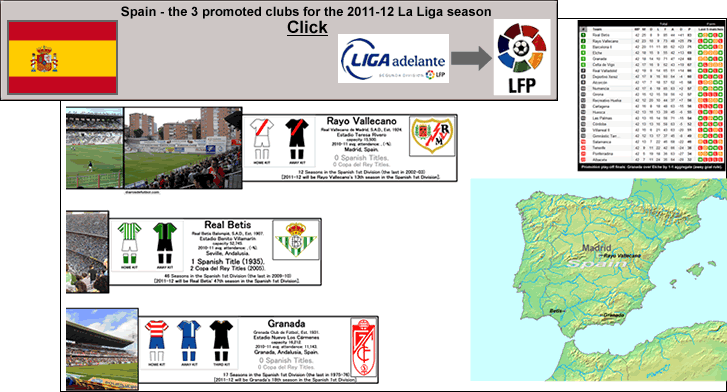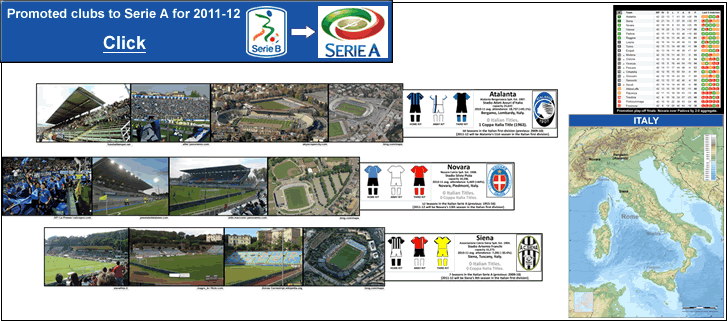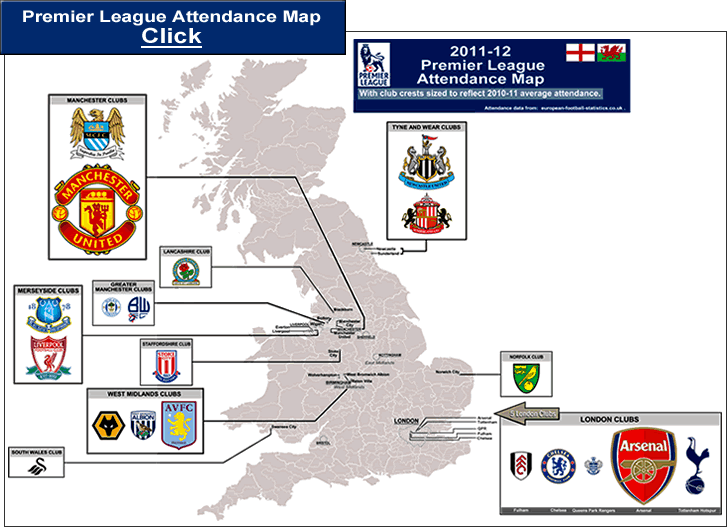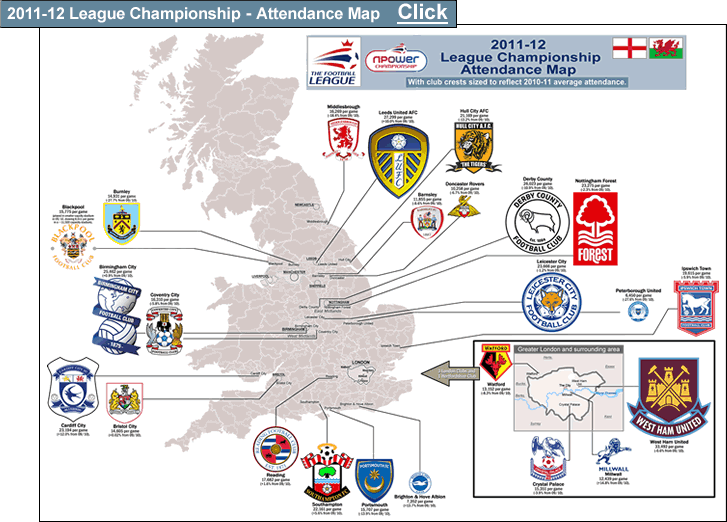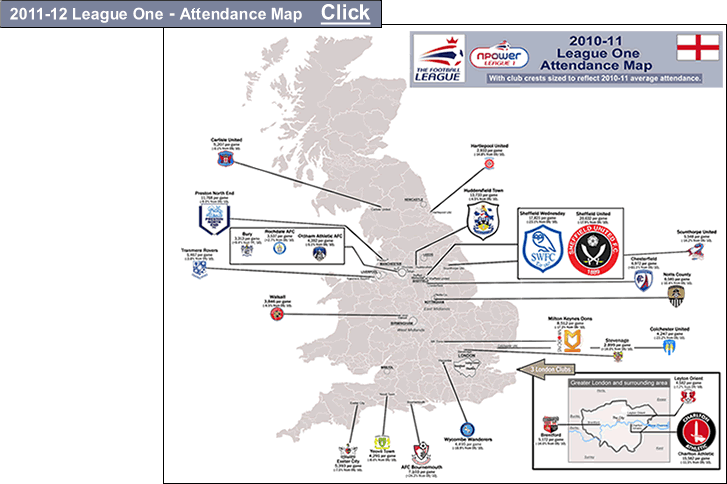
Dutch top flight – 2011-12 season, with 2010-11 attendance data
Eredivise – Results, Fixtures, Table (Soccerway.com).
The Dutch first division is called the Eredivisie. On the map page, you can see the locations of the 18 clubs in the 2011-12 Eredivisie. Attendance data from last season (home league matches) can be found to the right of the map.
This season, the 56th season of the competition, began on the weekend of 6th August. Reigning champions are the Dutch giants Ajax, of Amsterdam, who have now won 30 national titles in the Netherlands including 8 titles which preceded the formation of Eredivisie, and the first Eredivisie title in 1956-57. But before last season, Ajax had not won a title in 7 years. And midway through the 2010-11 Eredivisie season, it looked like that title drought would continue, after Ajax lost their manager (Martin Jol, who resigned in early December because the squad was playing so poorly). Then Ajax lost their leading scorer, the talismanic striker Luis Suarez (who was sold to Liverpool in January). Then they lost their star goalkeeper to injury (Maarten Skekelenberg, who has since moved to Roma). But the squad came together under the leadership of Frank De Boer, and meanwhile Twente and PSV dropped points in the run-up. So Ajax’s fine form in the deciding weeks led to a final dual-match showdown versus Twente – first in the KNVB [Dutch] Cup, and then on the final day of the Eredivisie season. Although Ajax lost the Dutch Cup final to Twente (by a score of 3-2 in aet), a week later they showed up for the more important of the two matches, and handily disposed of Twente 3-1, to claim the title, with Siem de Jong scoring a brace. Frank De Boer is now, along with Rinus Michels and Ronald Koeman, one of the 3 players to have won a title as a player and a manager of Ajax.
It wasn’t just player attrition and a managerial change that the Ajax squad had to contend with last season – there was also a very public turf war within the Ajax top brass. Suffice to say that the 800 pound gorilla in the room, Johan Cruyff, is back with the leadership of the club now, after a half-decade-long turmoil within the Ajax board, so it looks like it will be bright days ahead for Ajax, what with the spiritual father of total football guiding the club and its player development system, {see this, from WorldOfAjax.wordpress.com, from 31 March 2011, ‘A free way for Johan Cruyff(?)‘.}
In that 7-year span when Ajax went without a title, 2 clubs emerged with national championships, breaking the quarter-century-long domination of the Dutch game by the Big 3 – the triumvirate of Ajax, PSV, and Feyenoord. Those 3 clubs had won every Dutch title from 1981-82 to 2007-08 (27 seasons). Then the small club from Noord Holland, AZ of Alkmaar, won the 2008-09 title after coming agonizingly close in the seasons before [AZ had won the 1980-81 title; their 08/09 title is their second Dutch title]. AZ [pronounced 'Ah-Zed'] recently re-built and expanded their stadium, but it still has a capacity of only 17,000. Alkmaar has a population of around just 90,000 {2007 figure}. Even people from down the road in the freak-friendly city of Amsterdam consider Alkmaar to be a pretty freaky place, what with it’s fully-sanctioned window prostitution in it’s red-light district. After AZ shook up the status-quo in Dutch football, another provincial club took the baton the following season, with FC Twente, of Enschede, winning the 2009-10 title, by one point ahead of Ajax…{see this from Guardian.co.uk, from 2 May 2010, by Louise Taylor, ‘Steve McClaren goes from zero to hero as FC Twente win Dutch title‘. Enschede has a population of around 156,000 {2009 figure}. It was FC Twente’s first Dutch title. Twente play in the 24,000-capacity De Grolsch Veste, and the club pretty much plays to capacity these days. [FC Twente's current stadium expansion saw a recent tragedy {see this, from Guardian.co.uk, from 8 July, 'Second death following collapse of FC Twente stadium roof'}.]
In fact, clubs playing to high, above-90-percent-capacities is a recurring theme in the Netherlands, as you can see by the chart on the map page. Over half of the clubs – eleven clubs in the current season of Eredivisie – filled their stadiums to an above-90%-capacity figure last season (and Ajax was just below that at 89.3 %-capacity). But notably, only one of the Big 3 did – PSV, of Eindhoven, who are, like Wolfsburg in Germany (Volkswagen) and Sochaux in France (Puegot), a club that is bankrolled by a large multinational that makes durable goods. In PSV’s case, it is the electronics manufacturer Philips that has put the club on the map. PSV are the most successful club in the Netherlands in the last decade or so, having won 7 titles since 1999-2000, but their last title was 3 seasons ago in 2007-08. PSV play at the 35,000-capacity Philips Stadion. Philips Stadion is a pretty nice ground (with state-of-the-art fully heated seating and hi-tech turf-maintenance features) that is, unlike many of the first-division grounds in the Netherlands, right by the city center. Eindhoven has a population of around 213,000 and a metro-area population of around 440,000 {2010 figures}. To round out the population figures of the cities of the Big 3 clubs, Amsterdam [Ajax], the largest city in the Netherlands, has a city population of 1.2 million and a metro-area population of around 2.15 million {2010 figures}; while Rotterdam [Feyenoord], Holland’s second city, has a city population of around 611,000 and a metro-area population of around 1.21 million {2010 figures}. Feyenoord is starting to become like the Dutch version of Liverpool, because they have not won a national title since 1998-99, and are in retrograde, and in fact were in the bottom-half of the table last season, with a 10th-place finish, which included a 10-0 loss to PSV. The reason for Feyenoord’s title-drought and drastic drop in form is financially-based. However, Feyenoord might be out of contention these days, but the club can still pack them in, drawing 42,559 per game last season. Only Ajax draws better: they drew 47,316 per game to their 52,960-capacity Amsterdam Arena, which has a retractable roof and looks like it landed there from another planet. That’s par for the course in Dutch football, because in my opinion, this plucky little nation has created some pretty cool looking football grounds, as you can see in my previous post on the Eredivisie, {see this- ‘The Netherlands: 2009-10 Eredivisie, with 08/09 average attendances, and stadium photos‘}. Last season, the Eredivisie as a whole drew 19,296 per game. Notice that there are no running tracks in any of the top flight stadiums in the Netherlands. Thank goodness no one ever tried to combine an ice-skating oval and a football ground there.
_
Thanks to E-F-S site, for attendance data.
Thanks to the contributors to the pages at en.wikipedia.org, ‘2011–12 Eredivisie‘.
Thanks to Demis.nl for the base map, Demis Web Map Server.
